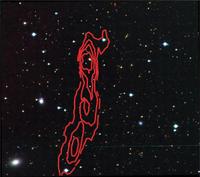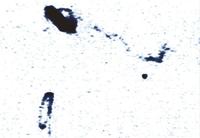The Dark Galaxy

Every time that we think that we’ve got the laws of physics, cosmology and biology nailed down, along comes another observation that has everyone scratching their heads.
So it is with the some very puzzling observations by the Hubble Space Telescope. Deep in space is a mysterious, galaxy-sized cloud of hydrogen known as VIRGOHI21.
Galaxies are thought to coalesce from normal, or baryonic, matter that has collected in clouds of dark matter. Dark matter is still a hypothesis, but a very interesting one. The trouble with this model is that surveys have turned up fewer galaxies than expected, suggesting that, for reasons unknown reasons, some galaxies are stillborn and simply fail to form stars.
When VIRGOHI21 was discovered in 2005 it seemed to provide the first evidence that dark galaxies existed. But other researchers suggested that this mysterious cloud had been pulled out of another galaxy and another passed by. What became known as the “hit and run” model.

But Robert Minchin of the Arecibo Observatory discounts such “hit-and-run” models. If one galaxy if rushing past another, its gravitational field should pull out some stars as well. And they have not been found. Minchin and his team used the Hubble Telescope to observe a patch of sky 50,000 by 50,000 light years across, centered on the position of the hydrogen cloud. They found only 119 red giant stars. That is the number found in a typical region of the same size in intergalactic space and three times fewer than expected if the cloud were a large piece of celestial wreckage.
These new images they do confirm a mystery raised by previous studies. The object’s normal matter weighs a few hundred million times the mass of the Sun. But its dark matter – inferred by studying the rotation speed of the cloud – appears to weigh at least 100 times as much.
That ratio is much higher than expected – in all other galaxies, dark matter outweighs normal matter by a factor of only 10. “Even if this is a dark galaxy, it is not what you expect to find. The number of baryons is too low,” said Michael Merrifield of the University of Nottingham in the UK, who was not on Minchin’s team.
Minchin agrees that this is a puzzle. A number of surveys at Arecibo and other radio observatories aim to find more examples of dark galaxies, which could shed light on how much dark matter they contain. But so far the surveys are finding little to match the characteristics of VIRGOHI21.
You can watch an animation showing VIRGOHI21 and its two galactic neighbours from a variety of perspectives.
Anyone who thinks that ANY current model has all the answers is sorely mistaken.
I was interested recently to see that a number of authors who have recently re-analyzed several of the pillars of science, and asked whether the current model of evolution – chance happenings leading to large scale change – is mathematically possible. Others have pointed out that Einstein’s reputation is largely built on two pillars: four days of earlier experimental work performed by two scientists called Albert Michelson and Edward Morley. And others have claimed that his first contribution was not original at all, but was a contribution to the theories of two other scientists named Ludvig Lorenz and Henri Poincaré, though he failed to reference them. The second is that experimental work confirmed his theory of relativity, when in fact several experimentalists produced data that did not support him. But they were ignored.
The good news is that we have methods that enable us to ask questions and obtain answers that move our understanding forward just a little more.
What other discoveries are waiting out there? Discoveries that may turn our worldview upside down?
“We must have strong minds, ready to accept facts as they are.”
–Harry S. Truman (American Statesman and, from 1945-1953, 33rd President of the United States, who made the decision to drop the atomic bomb, 1884-1972)






